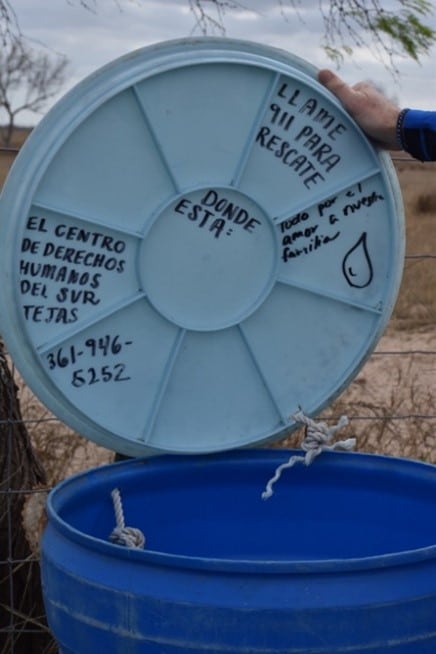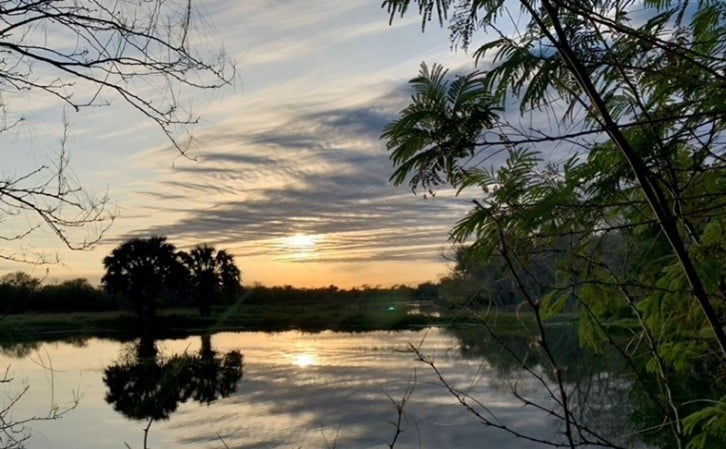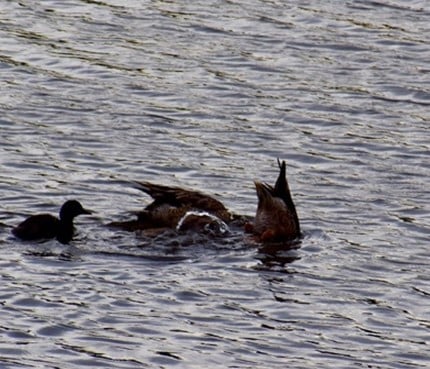“Sharing Place” by Steve Sedam
 —Following a February 2023 Trip to the Texas-Mexico Border with 15 FHC ITF members,
—Following a February 2023 Trip to the Texas-Mexico Border with 15 FHC ITF members,
this essay was written by Steve Sedam in May, 2023
It is late morning, and she is rising. Rising. Five feet of broad wings spread on her five-pound frame;
she rises higher still, barely moving. Her dark feathered body feels the heat of the tornado-
shaped thermal, a gift to Black Vultures like her who ride invisible waves of lift. Cool
morning air yields to interference from the onslaught of intense heat, 93-degree
and climbing. In ascending circles above the dry south Texas scrubland,
small observant black eyes on a bare gray head see the bend of the
planet far away. Above her, below her, she sees her mate, parents,
and siblings. A devoted family aloft together. They have been
residents of this place for many generations over many
centuries. Nearly everything they do, they do together.
A slight tilt to the left,slight tilt to the right, then back,
she climbs further upward, soaring higher than any bird.
Beneath, she sees roads, cattle, and humans walking on
sandy soil. When a feathered family discover a carcass,
down they go, sometimes in large numbers — the carcass
is picked clean, leaving only skeletal remains. These birds
are essential companions to this last stop on the
relentless cycle of life. What lives dies.
What is dead gives life. Their feast
can be any size. Often, it’s cattle
from one of the ranches.
New to their diet in recent
years is the carcass
of a loved, lost
migrant...
“You want to slip the patrol? Start walking!,“ he howls.
Forty miles north of the U.S.-Mexico border and about 30 miles south of the Falfurrias Customs and Border Patrol Inspection Station on Route 281 in Brooks County, Texas, the smuggler/coyote snarls at the migrants to get out of the truck. It’s early, long before sunrise, dark, and chilly. They’ve come so far, no quitting now. They start walking several miles west of the station to avoid detection. No signposts or trail markers. Hour after hour they trudge in sneakers over soft sand around cactus, mesquite, scorpions, and snakes. With the temperature rising, the invisible cords of kinship pull them forward. That afternoon climbing over 100 degrees, the heat takes over.
So confused! Which way to go?
Spikes of prickly pear stab at ankles. Thorns from bushes scratch soft flesh.
Shoes shredding.
Intense sun. No shade. Crushing heat. Walking through sand reduced to shuffle.
Dry mouth.
Need water.
Face flushed, body temperature rising. Heat stroke?
Must rest. Just for a bit.
Sit down. Shoulders slouched.
Need water…
Need water…
Reach into pocket…pen, paper.
Leave note for wife, mother, father, sister.
Te amo mucho.
Lo siento.
Adios.
Close eyes. Exhausted, unable to move.
Head sinks, heart stops.
Final breath. Last act.
Carcass.
###
We watch 75-year-old Eddie Canales lift a large blue plastic barrel in to place within the right-of-way of Farm Road 2191 in Brooks County. On its side in big white letters is the Spanish word A G U A. He reaches into his truck for more gallon jugs of drinking water and sets them inside the barrel.
On the underside of the barrel’s lid in black marker is written “Donde Esta” [where this is] followed by GPS coordinates, “Llame 911 para rescate” [Call 911 for rescue], and “Todo por el amor a neustra familia” [All for the love of our family]. This is the 161st water station the South Texas Human Rights Center (STHRC) has made available on public right of ways and inside private ranchlands for thirsty migrants traveling on foot. The barrels need to be replenished routinely.

This visit with Eddie Canales took place the second day of a seven-day trip across the south Texas-Mexico border by a group of 15 from Forest Hill Church in Cleveland Heights, Ohio. With other stops at a migrant encampment, respite center, and food distribution sites, we were there to learn the stories of migrants from migrants themselves and those who seek to lessen their burdens.
Brooks County is the heart of the nation’s busiest corridor for undocumented migration. More migrants die in Brooks County than in any other county in America. High incidence of yearly deaths began in 2009. In 2012, the remains of 129 migrants were found. The following year Eddie, once a union organizer, formed the STHRC with a mission: “End death and suffering along the Texas-Mexico border.”
In 2021, the remains of 119 bodies were found in Brooks County. The count reached 80 bodies by mid-2022. According to Brooks County Deputy Sheriff Benny Martinez, the multiple of found-to-unfound bodies is likely 5 to 10 times. One estimate claims there are over 2,000 unfound bodies in Brooks County alone. Eddie believes that over the past 40 years, 40,000 to 50,000 migrants have died along the border from Texas through California.
Migrants move from great peril whether home is the Congo, Cuba, Guatemala, Haiti, Mexico, Nicaragua, or Venezuela. They travel hundreds to thousands of miles to escape an interwoven snarl of political oppression, gang violence, extortion, economic collapse, and ravages to their homes and livelihoods from climate change. They move yearning for what’s been lost: safety, security, freedom, survival.
Since 2014, farmers in Central America have experienced drastic changes in climate — multiple droughts and two of the most devastating hurricanes on record. These resulted in crop losses of 70% or more, often over consecutive growing seasons. When subsistence farmers cannot grow the food needed to feed their families and those who farm for wages lose their livelihoods, they move in search of something better.
Or consider Emmanuel, who, at age 24, witnessed his family randomly murdered when a gang of al-Qaeda militants opened machine-gun fire in their small rural village in northern Burkina Faso. He used all his savings to escape to safety in the United States, only to be denied asylum and imprisoned when he got to the U.S.-Mexico border.
Eddie receives calls on the STHRC hotline that a body has been found. Sometimes there is no body, only skeletal remains. Other times, what remains is an artifact – a backpack, a shoe, maybe a shirt.
In June 2022, smugglers left a migrant behind. Using GPS coordinates from his abandoned phone, he was tracked to a private ranch. The ranch owner refused to allow the migrant’s Hispanic family from Oklahoma to enter his land. Eddie was let in instead. He found the body. That was after Black Vultures, rodents and insects had come and gone. Eddie told them, “You don’t want to see what I saw.”
Using state funds, Texas Governor Abbott has created his $4 billion Project Lone Star to militarize enforcement of “trespassing laws” and other schemes aimed at punishing fathers, mothers, and children moving from desperate conditions. While this vicious political extravagance runs amuck, no system has been established to determine if a migrant is in custody, missing, or in the morgue. There’s no way for families to know what happened to their lost loved one.
Day after day, body after body, Eddie walks the border between cynicism and hope. Eddie is getting too old for this but continues — a searing search for justice. Like Eddie, you want to believe that somewhere beyond the horizon, just out of view, this cataclysm becomes a catalyst. Agents of pain are transformed into angels of relief. Residents share resources with migrants. Names are known. Families are reunited with the smiles of the living; dignity is restored.
[See the award-winning PBS Documentary, “Missing in Brooks County” available on Amazon Prime.]
# # #
On the morning of the fourth day of the trip, the test strip confirmed I had Covid. My friends from church went on without me. In planning the trip, I was hoping we’d have time to visit one of the most amazing respites for birds in America, the 2,088-acre Santa Ana National Wildlife Refuge. It was only 20 minutes from where we were staying. But there was too much to do. We couldn’t fit it in.
Ironically, my cloud of Covid had a silver lining. A few days later and feeling much better, I hopped into a spare van, and drove south, heading to the Refuge. Yes, I wanted to see some “life birds.” But frankly, I was craving some solace. Remarkable beauty, abundance, and diversity might be just the ticket. Of equal value, I was hoping for lessons from the birds of Santa Ana. I wanted to witness the dynamics of their relationship, the one between long-distant migrants who travel thousands of miles and resident birds who rarely leave. What do they have to show us?
Under sunny skies, the temperature is mild. A slight breeze from the south flows across the big, slow meandering Rio Grande forming the western edge of the refuge. A feeling of divine brushstrokes greets me as I move past the Visitors Center and head to the interior.
My first stop – the viewing platform overlooking Willow Lake North – I found a Great Egret and a family of seven White-faced Ibis. The large, graceful stick with liquid snow-white feathers and the purply, chunky Ibis bodies, out for an afternoon of poking around the marsh. The more I looked, the more I realized something was going on here.
The egret, who will eventually either remain here or fly across the American Midwest, stayed with the Ibis, a migrant who will later fly to breeding grounds in the Mountain West. Where she went, they followed. She was their patient guide. “Now let’s try over here,” and so they did.

Out ahead on the vast marsh, Greater Yellowlegs, Mottled Ducks, some Gadwall, American Coot mixed in with a few Long-billed Dowitcher and Pied-billed Grebe peacefully went about their business. Neighbors, friends, strangers, family were sitting around, swimming, feeding, napping, doing what birds do. Residents and migrants shared life-sustaining resources. There was enough for all.
A remarkable calmness had settled over the place and entered me. The feeling grew as the trail took me through a cathedral of cottonwoods draped with Spanish Moss whose tangles dangled delicately in the breeze.
I reached the far side of the marsh and walked over the boardwalk. Soon, I found myself among tall, wispy willow trees. The floating notes of a sweet, sweet song gently blended into my reverie. Near the top of an adjacent tree rested an Altamira Oriole. Exquisitely garbed in bright orange with a black mask, this is the largest Oriole in the states. Not migratory, a tiny portion of its range gets up into the Rio Grande valley with most of it in Mexico and Central American countries. Fitting to their song, Altamiras are not territorial, even in breeding season.
The more I walked, the more I realized I was moving through an answered prayer. Here, among the birds, respect for all beings was the norm. Walls and borders were useless to these lives in motion. They accepted each other. Found community. Projected harmony.
The life of birds is not without violence. Some birds eat animals including other birds as part of their diet. Vultures consume raw meat of the dead and prevent a carcass from becoming vectors of disease. Their violence allows for survival within the bounds of balance, nothing punitive, no ego-driven displays of power.
Further on, a melodic sound filled the sky. Again, there it was. This couldn’t be one bird. Into view came a flock of thousands of Red-winged Blackbirds dipping and diving in acrobatic grace, a singing chorus, all as one. How could this be? I know this common creature only as fiercely territorial individuals who plead or peck at you to move away. At this place, before dispersing to breeding grounds, theirs was a different nature.
In the corner of my eye, a silhouette. I looked up. Perched high on an upper branch of a large tree was a handsome hawk with bold markings of dark brown and chestnut red. A Harris’s Hawk, the most social of North American raptors, known to cooperate at nests and hunt together as a team. Securely positioned, she gazed at the horizon, sharing her place in the soft light of the setting sun.

